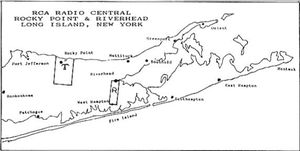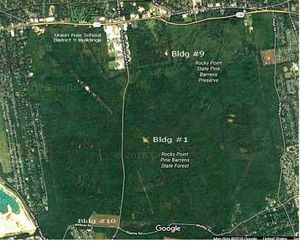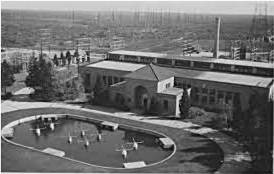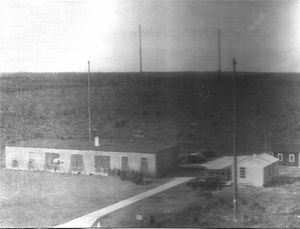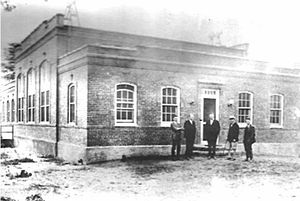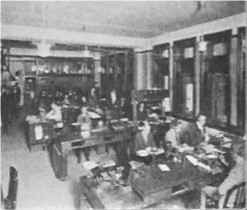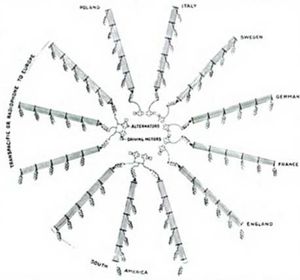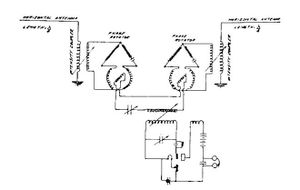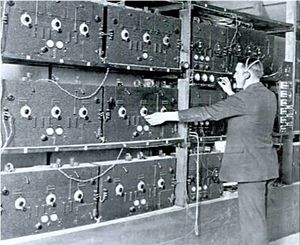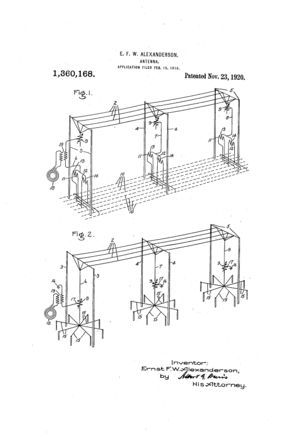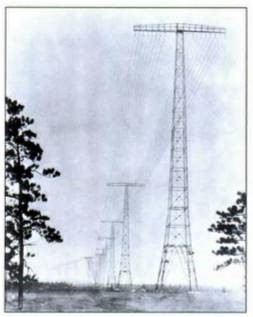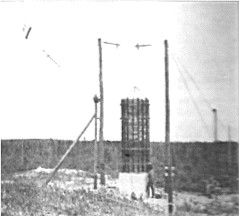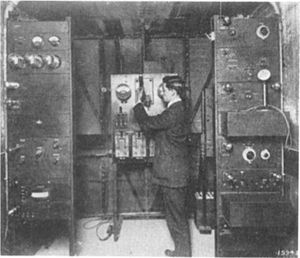Milestones:RCA Radio Central
This is a temporary page. The final version of this page can be found on the Engineering and Technology History Wiki
Title
RCA Radio Central, 1921-1978
Citation
On 5 November 1921, the world’s most powerful transoceanic radio facility at the time, RCA Radio Central, was inaugurated. Located at Rocky Point and Riverhead, New York, its Alexanderson 220 kW, 18.3 kHz transmitters and Beverage long-wire receiving antennas provided reliable worldwide radio communications. In succeeding years, RCA's research laboratory also developed diversity radio reception, rhombic and folded-dipole antennas, the first transoceanic single side-band channels, and commercial facsimile service.
Street address(es) and GPS coordinates of the Milestone Plaque Sites
Rocky Point Union School District90 Rocky Point - Yaphank RoadRocky Point, NY 11778Coordinates: 40.896680, -72.945430, Rocky Point Union School District90 Rocky Point - Yaphank RoadRocky Point, NY 11778Coordinates: 40.896680, -72.945430
Details of the physical location of the plaque
The plaque will be mounted on the main entrance hallway in the vestibule of the Rocky Point High School.
How the intended plaque site is protected/secured
The High School is locked down at all times during the school day and visitors can enter into the school by displaying a valid license. The building has security personnel and an alarm system.
Historical significance of the work
To understand the historical significance of the work carried out over 56 years at the RCA Radio Central facilities, one must first consider its unusual origin (Ref. 1). It marked the first and only formation of a business at the instigation of the War Department. Its origin was in the culmination of United States political interest at the end of World War I to maintain its dominance in international communications and the Navy Department’s goal of ensuring reliable communications with its worldwide fleet operations.
Up to the beginning of World War I, the primary wireless company in the United States was the Marconi Wireless Telegraph Company of America. Its primary source of business was the marine message service that provided both commercial and marine safety services for ships and had achieved international significance. Although incorporated in New Jersey and known as American Marconi, the company could not demonstrate that it was not under British foreign control. Consequently, its operations were taken over by the Navy. By the end of the war, the company was producing equipment for the Navy and the Navy had to relinquish all of the Marconi facilities or the government had to change the law so that it could remain in the commercial message business.
The proposed solution was to have the British interests in Marconi purchased by an American company. The new company was incorporated in the state of Delaware on October 19, 1919 as the Radio Corporation of America (RCA). RCA received the American Marconi patents, its high powered stations and its contract with the U.S. Shipping Board for the maintenance on 400 of its ships. Of particular interest to the United States were three of the articles of incorporation. One prohibited the election of directors who were not U.S. citizens. Another restricted to 20% the amount of stock that could be owned by a foreigner. The third permitted participation by the United States government in the administration of the corporation’s business. Edward Nally, who had been President of American Marconi was elected Chairman of the Board and David Sarnoff who succeeded him, became Managing Director.
The new company’s primary business objectives at its founding were to be the dominant provider of worldwide wireless commercial communications, which at the time was American Marconi a subsidiary of the British Marconi Company, to provide equipment and services for seagoing vessels and to compete with the undersea cables by offering improved reliability. To provide the worldwide service the company soon undertook a massive project to build a "Radio Central" transmitter center at Rocky Point, Long Island, New York, which together with its receiving station at Riverhead and central office in New York City would achieve the vision of communication engineers to transmit messages to all points of the world from a single centrally located source. Although triode versions of vacuum tubes were already being used by ham radio operators, experimenters and researchers as oscillators and amplifiers at the lower short wave frequencies, the very low frequencies were being used at a number of stations to provide reliable higher power transmissions utilizing Alexanderson Alternators. In a 1923 paper (Ref. 5) Alexanderson co-authored, he stated the advantages of long wave radio propagation compared with that of short waves. As part of the formation of RCA, ownership of the two high power Alexanderson Alternators that had been ordered by Marconi was transferred to RCA and became the basis of the planned global reach employing twelve directional transmitters planned for Radio Central.
The long antennas required for the very low frequency operation of the Alexanderson alternator operation at 18.3KHz and the long wire Beverage antenna for receiving utilized two sites, 7000 acres at Rocky Point and 2000 acres at Riverhead on Long Island, NY (Fig. 1). Today, the original sites remain as preserves, the 6000 acre Rocky Point State Pine Barrens at Rocky Point and the 2700 acre David A. Sarnoff Preserve at Riverhead. Only remnants of the original massive steel antenna towers remain.
The inauguration of RCA Radio Central (Ref.1) occurred on November 5th, 1921 when President Harding pressed a button in the White House sending a worldwide telegraphic message of friendship over RCA Radio Central’s relay network to activate the first of the two 200KW Alexanderson alternators at Rocky Point. Acknowledgements of the transmission, which marked the first radio message sent by a president, were received from 17 countries, including Japan and Australia at the Riverhead receiving facility. For more than 70 years RCA Radio Central not only provided reliable world-wide radio communications but developed diversity radio reception, performed the first high-power vacuum tube experiments, established the first transoceanic SSB channels, developed rhombic and folded-dipoles antennas and the first transoceanic FAX service.
Features that set this work apart from similar achievements
Introduction
Occupying 9000 acres at two locations with 200KW transmitters, RCA Radio Central in 1922 was characterized as being both the largest and most powerful communications station. Its design linked transmitting facilities at Rocky Point and receiving facilities at Riverhead, through a system of relays utilizing existing telephone lines, controlled from its Central Traffic Office in New York City. The system marked the first time such widely separated communications facilities were controlled from a remote location.
The Facilities
Rocky Point
The three main operations buildings at Rocky Point were designated Bldg#1, Bldg#9 and Bldg#10. Figure 2 shows their locations.
Building #1 (Fig. 3) was the administration and operations building. The original two Alexanderson alternators were installed in the building and with the subsequent shift to shortwave operations in the 3-6.7 MHz frequency range more than 80 tube transmitters with power ratings up to 40 KW were also installed. The two story building design was based on Spanish architecture. The control room for transmissions was on the main floor. The fountain and pool in front of the building were both decorative and functional. The jets seen in the photo maintained the pool’s water reservoir used for cooling the Alexanderson Alternators.
Building #9 (Fig. 4) was built to accommodate additional transmitters to meet increased demand for point-to-point circuits and to provide backup for the subsequent tube transmitters in Building #1. It was located about 1.2 miles east of Bldg#1 (Fig.2). It was a two story Art Deco design building with decorative panels inside and related designs on the outside walls.
Bldg#10 (Fig. 5), the Research and Development Laboratory, originally headed by Harold Beverage, was at the southern end of the Rocky Point property (Fig.2). Compared with the architectural designs of Buildings #1 and #9, it was unimpressive. The initial work carried out in the building was the design of the long wave antenna towers, grounding systems and relaying technology and later, for HF vacuum tube transmitters and antennas.
Riverhead
RCA’s first research laboratory established by Harold Beverage in October 1919 at Riverhead was in a tent on what is now the 2000 acre David Sarnoff Preserve. It was at Riverhead that the experimental work leading to the development of the long wire Beverage directional antenna was developed and became the basis for the receiving part not only of Radio Central but for all RCA wireless receiving stations. From the very beginning, it was planned to incorporate Beverage’s work and facilities as part of Radio Central’s receiving facilities.
The original wooden permanent building was no longer adequate. A second brick building which included frequency measuring equipment was built in 1922 (Fig. 6).
Central Traffic Office, New York City
All of the messages sent from Radio Central in Rocky Point were controlled from the Central Traffic Office (Fig. 7) at 64 Broad Street in New York City. Incoming messages to the office for transmission arriving via telephone lines, hand-written or typed, were retyped on to a punch tape in Morse code and then sent over telephones lines to Radio Central at up to 200 words per minute, more than five times the usual speed using semi-automatic telegraph keys. Receivers monitored the signal transmitted from Rocky Point. In the central traffic office were six transoceanic receivers, six local monitoring receivers and six automatic tape transmitters. One-fifth of the telegraphic communications between the United States and Europe passed through the central traffic office (Ref. 2).
Transmitters
When construction of Radio Central started vacuum tubes were already being used by ham radio operators and researchers as oscillators and amplifiers at the lower short wave frequencies, while very low frequency high power Alexanderson alternators were used at a number of stations to provide reliable transmissions. With two new Alexanderson alternators transferred from Marconi to RCA and Alexanderson acknowledging that while the short waves had an advantage for distances less than 3000 miles because of their low “absorption,” for longer distances, wavelengths over 11,000 meters provided the greater reliability, the decision was to use the alternators as the transmitters.
It was planned to install twelve 200KW Alexanderson alternators at 18.2KHz with twelve radial configured directional antennas (Fig. 8) to provide not only reliable around the clock transoceanic communications with Europe, but with the world.
Only two of the Alexanderson alternators were installed and operational. By the time Radio Central was completed short wave transmitters had become available at a fraction of the cost of a Alexanderson alternator. It had cost General Electric $1 Million to develop the alternator for Marconi. Marshall Etter (Ref. 3) stated that, “It was a good thing they didn’t build the rest………would’ve been obsolete and RCA would have been in serious financial trouble.” The two alternators remained in service until the 1950s. During WW2, modifications were made to also key the alternators from Washington, DC. as the long wavelengths permitted communications with submarines while submerged.
The alternators were installed in Building #1, the Administration Building. Subsequently 80 HF transmitters with power ratings up to 40 KW were also installed in the building. Transmissions included telegraph frequency shift keying, single side-band and double side-band carrier modulation. With the need to accommodate additional point- to- point transmitting circuits, Building #9 was built with a small cooling pond for 24 transmitters operating in the 3.0 to 30 MHz frequency bands with up to 55 KW ratings.
Power for the Rocky Point facility was provided by the Long Island Lighting Company: 23,000 volts, three phase 60 cycle current to a substation that was on the road to Building #1. Emergency power was available at both buildings, 225KW at Building #1 and 250KW at Building #9.
Receivers
With the decision to build Radio Central, the Riverhead site became the central receiving location for the Radio Central complex with Harold Beverage in charge of developing receivers. The receivers were adaptations of his “Barrage Receiver,” which differed in several respects from other systems that had been used in transatlantic communication. They represented a significant improvement in the reception of receiving radio messages by being able to tune out interfering stations. In his 1919 paper, (“The Barrage Receiver,” Transoceanic Radio Communication, Telegraph and Telephone Age,) Alexanderson described it as a fundamentally unidirectional receiver that required an aperiodic antenna with regard to the receiving frequencies of interest. There were six Barrage receivers installed in the original wooden building (Fig.10).
The Barrage receiver was a modified standard radio design consisting of two sections as shown in Figure 9. The first section contained a double set of phase rotators to null out interfering received signals, the second section was a standard audion triode detector amplifier. While the Barrage receiver was developed primarily to avoid interference from stations during transoceanic operations, it was found to reduce coupling when simultaneously sending and receiving from small shore or ship stations. It also helped to minimize interference from co-located transmitters at the same location.
Riverhead began operations with four of the Barrage receivers shown in Figure 10 with provision to install as many as nine. While only two were required for the initial Alexanderson alternators, the others were used for other Radio Central stations. The first section of each receiver consisted of double phase rotators (Fig. 9), followed by three stages of RF amplification, a detector and two stages of audio amplification. Among subsequent receiver development started at Riverhead in the early twenties by Beverage and H.O. Peterson was the diversity receiver to compensate fading of short-wave signals by separating receivers and their antennas. They patented their work in 1931(Patent # 1819589) and in 1933 built and demonstrated a triple diversity receiver. By the late twenties, 41 triple-diversity receivers had been installed at Riverhead for communications with 26 different countries.
Transmitting Antennas
Alexanderson was RCA’s first chief engineer and responsible not only for the installation of the alternators but also the design of the antennas. At the time the prevailing concept was that operating at the very low frequencies permitted reception over longer distances and with greater reliability. Wireless stations at the time used vertical antennas, because of the very long wavelengths and required heights, full size resonant antennas could not be built. The vertical antennas used were electrically short and inefficient in terms of the power radiated relative to the transmitter’s input power. Alexanderson, while with General Electric addressed the design of an efficient antenna for very low frequency operations and in 1920 obtained a patent (#217379) for a flat top antenna tunable to multiple frequencies (Fig. 10a).
At rocky Point he and his associates adapted his original flat-top antenna system for use with the high power of very low frequency alternator. It consisted of six 410 foot steel towers (Fig. 11) with 150 foot crossbeams on which were mounted 12 parallel wires, 14 feet apart, that extended for 7500 feet in length with loading coils (Fig. 12. Note size relative to figure.) to provide tuning for operating at different carrier frequencies and for matching the antenna impedance to the transmitter. The counterpoise ground for the antenna consisted of buried wires that were the equivalent of a copper plate 2000 feet wide and three miles long. (Ref 2, p697.) The 12 towers for the two Alexanderson alternators remained standing until December 13, 1977 when the last of them was demolished.
Receiving Antennas.
There were two principal types of antennas when Radio Central started operations in 1922. The antenna for the Barrage Receivers consisted of two insulated wires laid on the ground a distance of two miles in each direction from the receiving station and the Beverage antenna..
Beverage who had worked at G.E. with Alexanderson while he was developing the flat top antenna for transmitters had been at the RCA Riverhead location since 1919 working on directional wave antennas. By 1921 he had installed experimental long wave antennas nine miles long, so when Radio Central opened in 1922 he had two long wave directional antennas working, one nine miles long and the other 7 miles long and only 30 feet above ground. In 1921 and 1922, he had received four patents based on his original design in which one end of the antenna was pointed in the direction of the received signal, terminated in a resistor to ground and the other end connected to the receiver with a matching circuit for the antenna’s characteristic impedance.
Research, Development and Firsts
Research and development at Radio Central was carried out over the many years of its operation, initially in support of very low frequency communications operations and subsequently in the applications of electronics. As vacuum tubes were developed for transmitters and receivers operating at the short wave frequencies that could provide reliable communications using relatively low power, smaller antennas and at less equipment costs, the research and development focus shifted accordingly.
The work carried out in the Research and Development Laboratory (Building #10.) was originally under the direction of Harold Beverage who started the first RCA lab at the Riverhead site. He was succeeded by Clarence Hansell in 1925 who among his many patents resulting from his work at the lab was one on Piezo-electric crystals (Patent #1874980) and another on the transmission of images over bundles of glass fibers (Hecht,Jeff, "City of Light, The Story of Fiber Optics, pp38-41, Oxford Univ. Press, 1999), the forerunner of the optical fiber cable. During the time he was in charge, 1925-29, the emphasis of the laboratory was in developing and placing in service the transmitting facilities with which RCA was able to maintain its leadership in the world-wide radio communications business. In 1929 the work of the laboratory was taken over by RCA Communications, Inc. and by RCA Laboratories in 1942.
Philip Carter, who was at the laboratory, designed the tower structures and grounding system used with the Alexanderson alternators and developed long-wire antennas for high frequencies. As part of his antenna research he developed the folded-wave antenna.
Nils Lindenblad, also at the lab designed the original NBC television antenna installed atop the Empire State Building in 1938 and Ludwig Batterman who worked with him invented the coaxial cable connector (Patent #2153527) that permitted matched cable impedances eliminating standing wave reflections.
The Diversity receiver developed at the Riverhead facility by Beverage and Peterson was described in the Receivers section above.
In January of 1923 the first experimental single-sideband (one way) transmitting and receiving station communication occurred between Radio Central at Rocky Point and New South Gate, near London. The system operating at 57 KHz was set up by Bell System research engineers with Radio Central (Fig. 13) personnel. It was publicly demonstrated and with the support of the British Post Office led to the establishment of the first commercial New York (Rocky Point) to London circuit in 1927. It was described in the December 1956, Proceedings of the IRE, by Arthur Oswald.
RCA was the first company to adapt facsimile to radio, and sent a transoceanic image of President Calvin Coolidge from New York via Radio Central to London on November 29, 1924. Two years later it began a commercial service of transmitting transoceanic photos by shortwave radio for the newspaper industry transmitting weather maps to ships at sea. RCA’s patented “Photoradio” technology was invented by Richard Ranger and Charles Young. (Coopersmith, Jonathan, “FAXED, The Early Rise and Fall of the FAX Machine,” John Hopkins University Press, 2015). It used a rotating drum and a photoelectric scanner to convert a document into a continuous tone that varied in pitch with changes in the image. The image was reproduced on the receiving end with another rotating drum having a stylus that pressed black carbon paper against white paper to reproduce the image.
General Electric performed the first experiments with high power vacuum tube transmitters at Rocky Point using an Alexanderson alternator running at low power as an exciter for GE’s tube transmitters. The success of these experiments contributed to the development of high power tubes and the demise of the alternator.
Early frequency shift keying trials were also performed using an Alexanderson alternator at Rocky Point to send the "mark" signals and another alternator at Tuckerton, New Jersey to send the "spaces." It proved unwieldy for regular use, but demonstrated its merits.
Significant references
Acknowledgements: The milestone committee of the IEEE Long Island Section is grateful for the help and original documents that were made available by the Rocky Point Historical Society who have kept the history and accomplishments of RCA Radio Central alive through their activities, original documents, journal, site artifacts and as a participant in the preparation of the milestone proposal. Among them Natalia Stiefel who included a detailed account of the history of RCA Radio Central in her publication, “In the Shadow of the Radio Towers,” and Robert Lundquist who had been the Station Engineer, both of whose expert help were available during the preparation of the milestone proposal. Special mention must be made for The Long Island Wireless Society which has long been active in preserving and documenting the many wireless stations that have been active since the early days of radio on Long Island and in particular, the David Sarnoff Preserve, the original Riverhead facility that was part of the RCA Radio Central facilities.
References: A search of the WEB will provide many more source documents than those listed below. Some of the material cited is no longer available although referenced on the web. A number of documents no longer available or out of print used in preparing the proposal were provided by the Rocky Point Historical Society and the Long Island Wireless Society. Original texts of Reference 3 and Reference 4 are included though both cover the origins of RCA. The former provides the context with regard to both the commercial and technical competition of the time while the latter records the history from the Navy’s and the U.S. Government’s views militarily and politically.
Ref. 1: Opening of New Long Island Station of the Radio Corporation of America (Excerpts)
Ref. 2: THE WORLD'S GREATEST RADIO STATION. Taussig, Charles William. “The Book of Radio,” 1922, pages 312-327.
Ref. 3: The Beginnings of Radio Central. Williams, Ralph; Etter, Marshall; McGraw, Bob; Bacon, Chris; “The Beginnings of Radio Central”, The Antique Radio Gazette, Spring, 1992.
Ref. 4: Birth of the Radio Corporation of America . Howmet, Captain L.S., Chapter XXX Excerpts, “History of Communications-Electronics in the United States Navy,” U.S. Government Printing Office, 1968.
Ref. 5: Design of Original RCA Radio Central Facility. Alexanderson, Reoch and Taylor, “The Electrical Plant of Transocean Radio Telegraphy,” A.I.E.E. Journal, July 1923.
Ref. 6: Antenna Transmission Line. Carter, Philip S., “Radio Transmission System,” Patent # 1623966, Filed June 25, 1923.
Supporting materials
Media:Hecht-CityOfLightFiberOptics1999.pdf
Media:Coopersmith-FaxedRCATransOceanicFax2015(1).pdf
Media:Aitken-ContinuousWaveRadioCentral1985.pdf
Media:AlexandersonEtAl-ElectricalPlantTransOceanRadioTelegraphy1923.pdf
